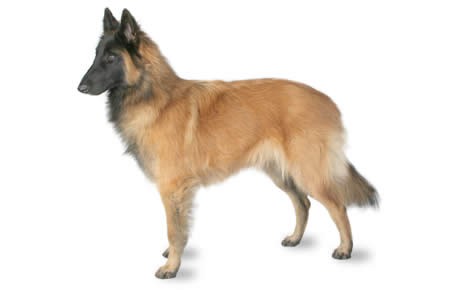Belgian Tervuren Breed Guide

Breed Group:
Herding Dogs
Get 30% off
Join our Newsletter
Sign Up Today
Belgian Tervuren Background Info and History
The Belgian Tervuren is one of four Belgian breeds that were once classified under the umbrella of “Belgian Sheepdog.” This breed is named after the Belgian town where they were originally developed. Belgian Tervurens were used for herding and as watchdogs, but eventually became prized as affectionate companion dogs.
The first Tervurens were recognized by the AKC in 1918 as a variety of Belgian Sheepdog but were classified as a distinct dog breed in 1959. Tervurens are commonly seen as service and therapy dogs, as well as competing in dog competitions. Tervurens also hold the distinction of being the AKC’s first Herding Champion.
Belgian Tervuren Temperament and Personality
Tervurens are an extremely intelligent and versatile breed. They exhibit a strong sense of loyalty and affection towards their owners. They demand a high amount of attention and can be possessive at times, but they are very loving and gentle.
Belgian Tervuren Training Tips
Belgian Tervurens are highly intelligent and their adaptability allows them to quickly learn new commands, think independently, and retain those commands over time. This allows them to be trained as service dogs, police dogs, or as shepherds. To capitalize on this, Tervurens should be trained and socialized from a young age.
Exercise Needs of Belgian Tervuren
Tervurens are an extremely active breed that has a high level of energy. Expect to spend a good amount of time every day with your Tervuren. Activities such as a long jog, vigorous play session, or extended training session are all excellent ways to keep him happy and avoid any mischievous behavior.
Belgian Tervuren Life Span
Belgian Tervurens usually live between 12-14 years.
Belgian Tervuren Breed Popularity
Tervurens are currently the 106th most popular AKC registered breed.
Feeding Requirements of Belgian Tervurens
The average Tervuren weighs between 45-75 lbs., so feeding requirements will vary depending on their activity levels and weight. This breed should be fed a high-quality food source that has a good balance of healthy proteins and fats, and avoids grain fillers. Expect to feed your pup between 3 and 4 cups of dry food a day, split into two even meals.
Belgian Tervuren Grooming
Tervurens should be brushed twice a week throughout the year. During the weeks when this breed heavily sheds in the Fall and Spring, it is necessary to brush your pup daily.
Are Belgian Tervurens Good With Kids?
Tervurens are an excellent breed for families. They are great companions for children and have a high enough energy level to play tirelessly.
Health Problems of Belgian Tervurens
Epilepsy
Epilepsy in dogs is one of the main health concerns in Tervurens. Specifically, Tervurens are prone towards developing idiopathic epilepsy, or rather epilepsy that is hereditary. Epilepsy is a condition where a dog will experience multiple seizures over time. In Tervurens, epilepsy begins to manifest between 2 and 5 years of age.
Hip Dysplasia
Hip dysplasia in dogs is a common condition that affects many large breeds, including the Tervuren. Hip dysplasia is caused by a loose fit between the femur and pelvis in the rear hip assembly.
This loose fit causes the cartilage padding these bones to wear unevenly over time. Later in the dog’s life, this wear results in painful arthritis, bone spurs, and eventually canine lameness. Hip dysplasia can be assessed from a young age during a routine physical examination by a veterinarian.
Elbow Dysplasia
Elbow dysplasia in dogs, like hip dysplasia, is caused by an improper fit between the radius and ulna in the front legs. Unlike hip dysplasia, elbow dysplasia manifests from a young age, typically during or after the puppy growth period. Tervurens have been found to be more prone to developing elbow dysplasia than hip dysplasia, although exact numbers of affected dogs is unknown.
Progressive Retinal Atrophy (PRA)
PRA is a degenerative condition that affects the photoreceptor cells in the retina of dogs. In this condition, the ability of the photoreceptor cells to receive and perceive light diminishes over time. The earliest sign of PRA is a diminished capacity to distinguish objects in low or dim light. Over time, PRA leads to complete loss of vision. Be sure to inquire with your breeder if PRA has ever been present in your pups line.
Other Resources
National Breed Website: American Belgian Tervuren Club
Rescue: Belgian Tervuren Rescue
